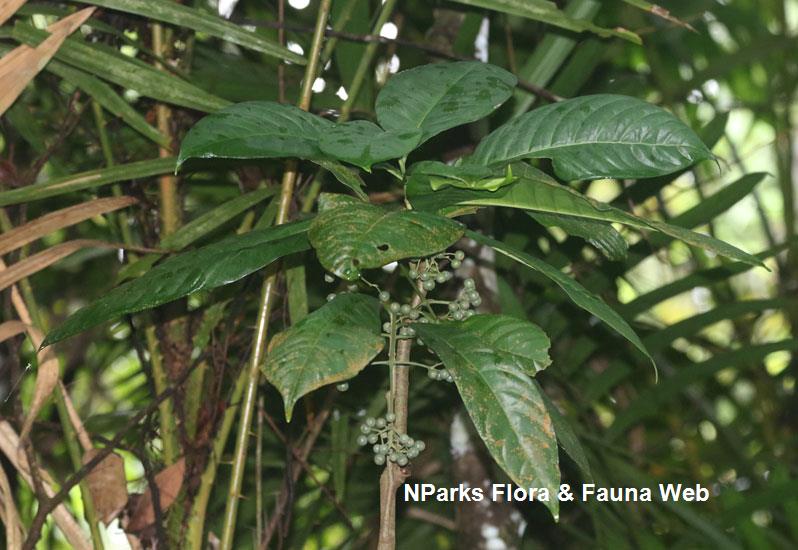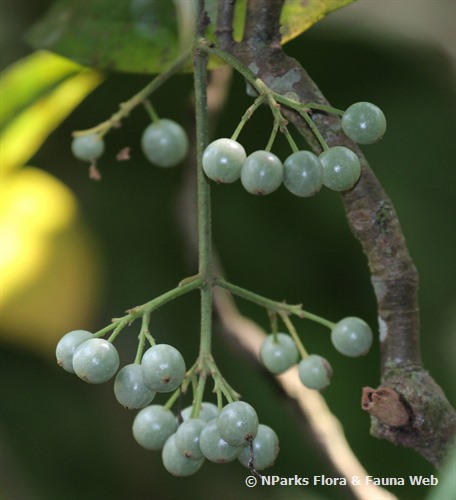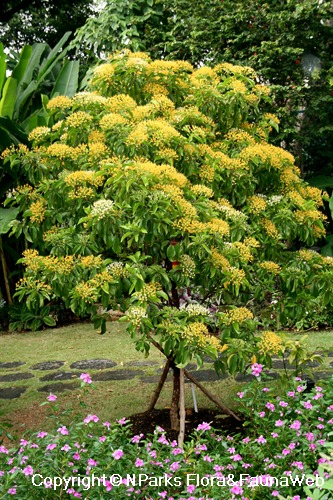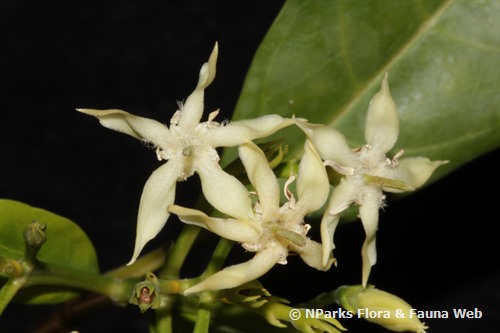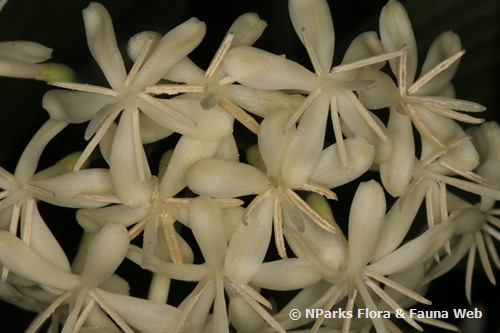
Back
Tarenna odorata (Roxb.) B.L.Rob.
| Family Name: | Rubiaceae |
| Synonyms: | Tarenna grandifolia (Hook.f.) Ridl., Webera grandifolia Hook.f. |
Tarenna odorata is a large shrub to treelet that is native to Singapore. Growing up to 2 m in height, it has leathery, elliptic, spoon to egg-shaped leaves, smooth on the top and sparse hairs can be found along the midrib and veins on the underside. Flowers are fragrant, whitish, pendulous borne on an inflorescence of 13 - 17 cm long. The fruit is borne in clusters, round, berry-like, turns from green to black upon ripening.
Name
Classifications and Characteristics
| Plant Division | Angiosperms (Flowering Seed Plants) (Dicotyledon) |
|---|---|
| Plant Growth Form | Shrub |
| Mode of Nutrition | Autotrophic |
| Maximum Height | 2 m |
Biogeography
| Native Distribution | Peninsular Malaysia, Singapore |
|---|---|
| Native Habitat | Terrestrial (Primary Rainforest, Secondary Rainforest, Freshwater Swamp Forest) |
| Preferred Climate Zone | Tropical |
| Local Conservation Status | Native to Singapore (Critically Endangered (CR)) |
Description and Ethnobotany
| Growth Form | It is a treelet or large shrub that can grow to 2 m tall. |
|---|---|
| Foliage | Leaves are leathery, elliptic, spoon to egg-shaped measuring 14 - 35 cm long and 4.5 - 13 cm wide. It has a tail-like tip (cuspidate), smooth on the top, sparse hairs may be found along the midrib and secondary veins. Stipules are found at the interpetiolar nodes, broadly triangular, brown when dried. Leaves are held on a stalk, 10 - 40 mm in length. |
| Flowers | Flowers are borne on an inflorescence covered in dense short hairs measuring 13 - 17 cm long. Flowers are pendulous, whitish, 5-lobed, tubular, fragrant. Lobes are long than the tube measuring at 5 - 7 mm long. |
| Fruit | The fruit is round, berry like, produced in pendulous clusters, each measuring to 5 mm wide. |
| Habitat | Occurs along lowland forests including swampy ground. <1> |
| Similar | Tarenna odorata and Tarenna fragrans are similar in appearance. The key differences are Tarenna odorata tend to produce larger leaves with a tail-like tip (cuspidate), held on a longer stalk, pendulous flowers and fruit clusters. While Tarenna fragrans have smaller leaves, broad pointed tip (acuminate), held on a shorter stalk, upright flowers and fruit clusters. The flowers and fruit of Tarenna odorata are pendulous, lobes are longer than floral tube compared to Tarenna fragrans which have upright flowers and fruit, the lobes are shorter than the floral tube. |
| Etymology | Genus epithet 'Tarenna' derived from Sinhalese name 'Maha-tarnana' for a plant from this genus which is distributed from the Indian sub-continent to Indonesia (Borneo). Odorata, in latin, means being fragrant, with reference to the scented flowers. |
Plant Care and Propagation
| Light Preference | Semi-Shade |
|---|---|
| Water Preference | Moderate Water |
| Plant Growth Rate | Moderate |
| Rootzone Tolerance | Fertile Loamy Soils, Moist Soils |
| Propagation Method | Seed, Stem Cutting |
Foliar
| Foliage Retention | Evergreen |
|---|---|
| Foliar Type | Simple / Unifoliate |
| Foliar Arrangement Along Stem | Opposite |
| Foliar Attachment to Stem | Petiolate |
| Foliar Shape(s) | Non-Palm Foliage (Elliptical, Obovate, Ovate) |
| Foliar Venation | Recticulate |
| Foliar Margin | Entire |
| Foliar Apex - Tip | Cuspidate |
| Foliar Base | Cuneate |
Floral (Angiosperm)
| Flower & Plant Sexuality | Bisexual Flowers , Bisexual Flowers |
| Flower Colour(s) | White |
|---|
| Flower Grouping | Cluster / Inflorescence |
| Flower Location | Terminal |
| Flower Symmetry | Radial |
| Flowering Habit | Polycarpic |
Fruit, Seed and Spore
| Mature Fruit Colour(s) | Black |
|---|---|
| Fruit Classification | Simple Fruit |
| Fruit Type | Fleshy Fruit , Berry |
References
| References | <1> Wong, K.M. et al. (2019). Flora of Singapore 13(1): 307. Singapore: Singapore Botanic Gardens, National Parks Board. |
|---|
Image Repository
Others
| Master ID | 2002 |
|---|---|
| Species ID | 3294 |
| Flora Disclaimer | The information in this website has been compiled from reliable sources, such as reference works on medicinal plants. It is not a substitute for medical advice or treatment and NParks does not purport to provide any medical advice. Readers should always consult his/her physician before using or consuming a plant for medicinal purposes. |

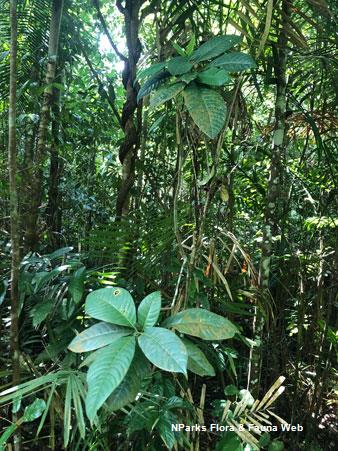
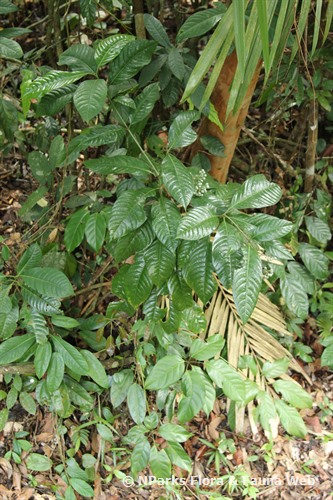
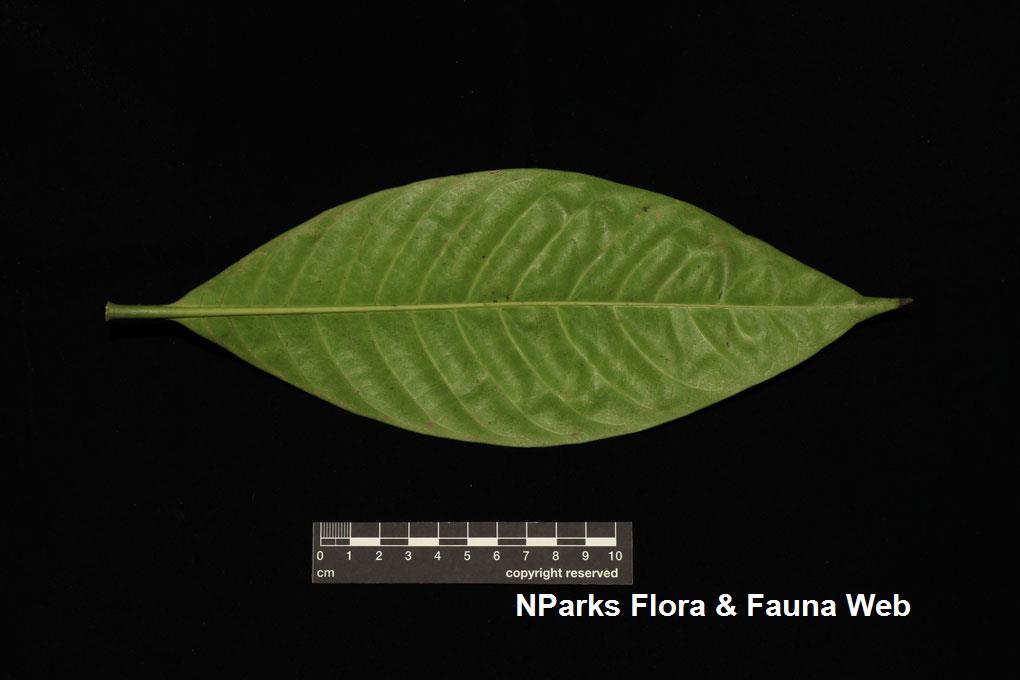
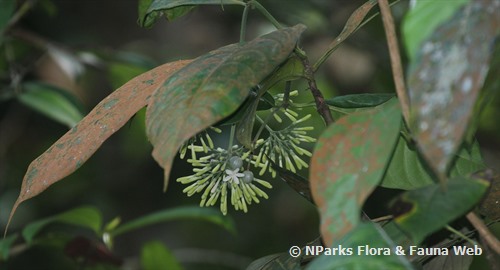
.jpg)
.jpg)
